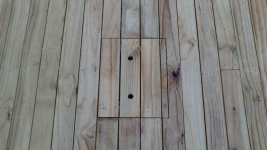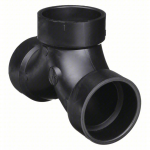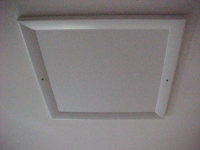Hey folks,
I'm scoping a residential project running a new branch circuit to outlets located around a newly constructed outdoor deck. The customer has requested conduit runs to be located in the deck framing, so as to minimize the amount of conduit that is visible. In that case conduit would run underneath the deck boards, and only penetrate the decking to reach outlets.
The deck is being constructed over a roof, will be enclosed by building/parapet walls on all sides, and is not accessible from below. Any boxes or conduit bodies located in the framing would naturally be covered by final installation of the deck boards. This raises the question of whether the boxes are "accessible" per 314.29.
314.29 Boxes, conduit bodies, and hand-hole enclosures shall be installed so that the wiring contained in them can be rendered accessible without removing any part of the building [or, in underground circuits...]
Accessible (as applied to wiring methods). Capable of being removed or exposed without damaging the building structure or finish or not permanently closed in by the structure or finish of the building.
An argument could be made that the conduit bodies can be rendered accessible by simply lifting a deck board, which does not damage the building structure or finish. I would love to hear folks opinion on that.
Alternatively, if continuous lengths of conduit were run to a single box, and an access panel was provided in the framing/decking above that box, would that suffice?
Thanks all -
Noel
I'm scoping a residential project running a new branch circuit to outlets located around a newly constructed outdoor deck. The customer has requested conduit runs to be located in the deck framing, so as to minimize the amount of conduit that is visible. In that case conduit would run underneath the deck boards, and only penetrate the decking to reach outlets.
The deck is being constructed over a roof, will be enclosed by building/parapet walls on all sides, and is not accessible from below. Any boxes or conduit bodies located in the framing would naturally be covered by final installation of the deck boards. This raises the question of whether the boxes are "accessible" per 314.29.
314.29 Boxes, conduit bodies, and hand-hole enclosures shall be installed so that the wiring contained in them can be rendered accessible without removing any part of the building [or, in underground circuits...]
Accessible (as applied to wiring methods). Capable of being removed or exposed without damaging the building structure or finish or not permanently closed in by the structure or finish of the building.
An argument could be made that the conduit bodies can be rendered accessible by simply lifting a deck board, which does not damage the building structure or finish. I would love to hear folks opinion on that.
Alternatively, if continuous lengths of conduit were run to a single box, and an access panel was provided in the framing/decking above that box, would that suffice?
Thanks all -
Noel



